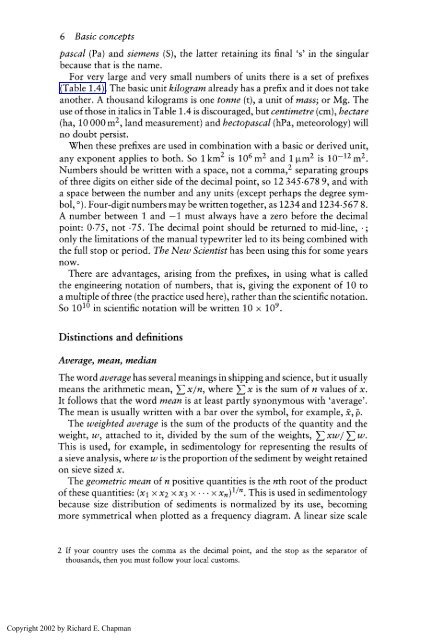Physics for Geologists, Second edition
Physics for Geologists, Second edition
Physics for Geologists, Second edition
You also want an ePaper? Increase the reach of your titles
YUMPU automatically turns print PDFs into web optimized ePapers that Google loves.
6 Basic concepts<br />
pascal (Pa) and siemens (S), the latter retaining its final 's' in the singular<br />
because that is the name.<br />
For very large and very small numbers of units there is a set of prefixes<br />
(Table 1.4). The basic unit kilogram already has a prefix and it does not take<br />
another. A thousand kilograms is one tonne (t), a unit of mass; or Mg. The<br />
use of those in italics in Table 1.4 is discouraged, but centimetre (cm), hectare<br />
(ha, 10 000 m2, land measurement) and hectopascal (hPa, meteorology) will<br />
no doubt persist.<br />
When these prefixes are used in combination with a basic or derived unit,<br />
any exponent applies to both. So 1 km2 is lo6 m2 and 1 Fm2 is 10-l2 m2.<br />
Numbers should be written with a space, not a comma,' separating groups<br />
of three digits on either side of the decimal point, so 12 345.678 9, and with<br />
a space between the number and any units (except perhaps the degree sym-<br />
bol, "). Four-digit numbers may be written together, as 1234 and 1234.567 8.<br />
A number between 1 and -1 must always have a zero be<strong>for</strong>e the decimal<br />
point: 0.75, not ,75. The decimal point should be returned to mid-line, .;<br />
only the limitations of the manual typewriter led to its being combined with<br />
the full stop or period. The New Scientist has been using this <strong>for</strong> some years<br />
now.<br />
There are advantages, arising from the prefixes, in using what is called<br />
the engineering notation of numbers, that is, giving the exponent of 10 to<br />
a multiple of three (the practice used here), rather than the scientific notation.<br />
So 10'' in scientific notation will be written 10 x lo9.<br />
Distinctions and definitions<br />
Average, mean, median<br />
The word average has several meanings in shipping and science, but it usually<br />
means the arithmetic mean, C x/n, where 1 x is the sum of n values of x.<br />
It follows that the word mean is at least partly synonymous with 'average'.<br />
The mean is usually written with a bar over the symbol, <strong>for</strong> example, 2,;.<br />
The weighted average is the sum of the products of the quantity and the<br />
weight, w, attached to it, divided by the sum of the weights, Cxw/ 1 w.<br />
This is used, <strong>for</strong> example, in sedimentology <strong>for</strong> representing the results of<br />
a sieve analysis, where w is the proportion of the sediment by weight retained<br />
on sieve sized x.<br />
The geometric mean of n positive quantities is the nth root of the product<br />
of these quantities: (xl x x2 x x3 x . . . x xn)'ln. This is used in sedimentology<br />
because size distribution of sediments is normalized by its use, becoming<br />
more symmetrical when plotted as a frequency diagram. A linear size scale<br />
2 If your country uses the comma as the decimal point, and the stop as the separator of<br />
thousands, then you must follow your local customs.<br />
Copyright 2002 by Richard E. Chapman






